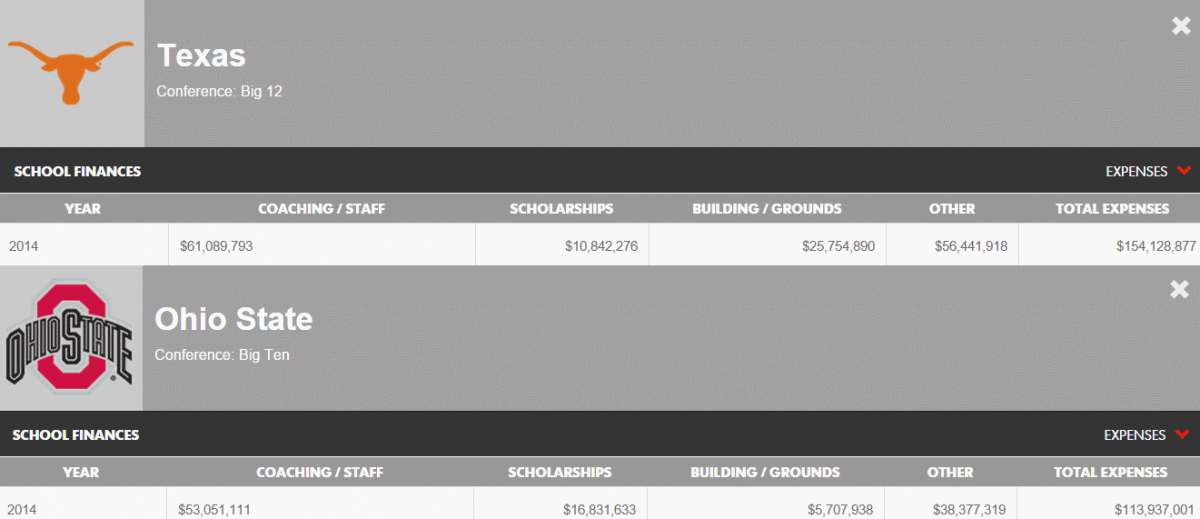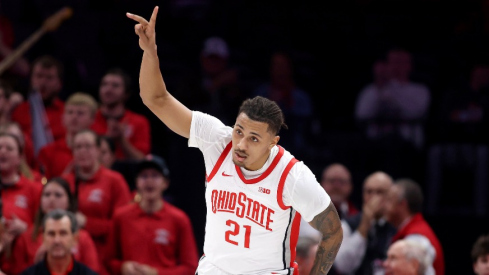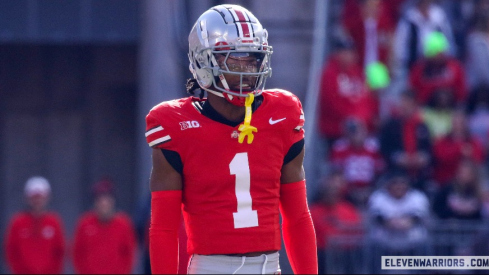The funding of collegiate athletics is a contentious issue in large part because some athletic departments seem to be so bad at spending the tens of millions of dollars that fall into their laps every year. This money comes from a number of different places, but in general you can expect the golden coins in that big ol' sack with a dollar sign on it to be accumulated from about four major places: donations to the program, licensing fees, ticket sales, and in every public university athletic department save seven, some kind of subsidy from the school and the students that populate it.
This is not news. USA TODAY has, for years, done a great job at maintaining an incredible site that details the various finances of every major public university athletics department in the country. It's been a godsend for writers like me who want to get students and alumni really angry about how their money is being spent, or more accurately, how their money is being burned to light a delicious Cuban cigar in the mouth of a trained chimpanzee that their AD just bought for his yacht because the truth is that while many schools give the impression of a financial need, the reality is often different.
I'm typically the fart joke and MS Paint guy on 11W, but what brought me back to the NCAA Finances page was this excellent article by Spenser Davis over at the OU Daily, the University of Oklahoma's student newspaper. In it, he breaks down the average cost of a student ticket in each of the Power 5 conferences, and then goes on to detail how much a season ticket costs at each school. It's one of those extremely handy articles that you'll bookmark and then forget about, but Davis deserves a lot of credit for this.
Where I slide into your 11W DMs like woah comes right after this addendum that Davis added, presumably at the request of an irritated Oklahoma administration:
Associate Athletic Director Kenny Mossman commented on this story in an email earlier this afternoon. Mossman first addressed the average price OU, the rest of the Big 12 and the SEC.
"It is difficult to compare financials with a large number of schools because circumstances vary. One of the biggest influencers is student fees. A number of schools assess a fee that supports athletics. OU does not," Mossman said.
That's true! OU, along with LSU, Texas, Ohio State, Nebraska, Purdue, and Penn State do not take any fees from their universities, student or otherwise, in the form of subsidies. That makes them a rarity in college athletics, as the vast majority of schools take occasionally substantial amounts from the people that go there.
So, in the spirit of Spenser Davis' original post, I decided to look at each of the Power 5 conferences and combine his look at ticket prices with my much less credible look at two additional statistics: the subsidy that schools receive in total and the difference between their expenses and revenue. The whole point to this incredibly unscientific (and I stress unscientific because I'd be remiss if I didn't shout out my girlfriend for helping me figure out how to use Excel for this) endeavor is to identify the worst of the worst in each of the Power 5 in terms of the financial deal that students are getting from the athletic departments that they enjoy.
It's also important to note that "subsidy" is also a tricky word, because for every school that means something else, depending on how that school allocated money during that year. It's probably unfair to look at total subsidy numbers and imply that an athletic department is bilking its school out of millions of dollars. Different accounting can mean that the cost of a scholarship can also vary wildly from school to school, depending on how they want to use it to suit their needs.
That's why, for the purpose of this article, subsidies will be mostly discussed in terms of student contributions rather than overall dollar amounts from the school.
This is by no means definitive or authoritative, but if we can shame Rutgers into decreasing their student subsidy to something less than a down payment on a house, we'll call this a win for everyone and go home.
PAC-12
The Pac-12 is interesting in that every school takes a subsidy of some kind, but some schools are infinitely better at managing said subsidy and revenue in general than others. The Pac-12 is also interesting because Oregon had roughly a trillion damn dollars. Seriously look at this crap:

Okay, now look at it again. Oregon takes a small subsidy from students for God knows what reason when they're 86 million in the black, but also look at that contributions number from year to year. I'm not a betting man, but if I had Phil Knight's money I sure as hell would be. An athletic department with 196 million dollars in revenue in 2014 has no business taking any amount of money from their university (or charging an NCAA-high 52 dollars per football ticket for students) but thanks to the bottom feeders in the Pac-12, the Ducks are off the hook.
See, four Pac-12 athletic departments take subsidies of over 10 million dollars from their schools; Colorado, Washington State, Arizona State, and Oregon State all need that sweet, sweet cash to function, I guess. Still, I'm going to laser-focus on Oregon State because A) student funds account for 2.5 million of their 12 million dollar subsidy, B) that's somehow almost 20% of their total athletic revenues, and C) did I mention that they're heavily in the red? Because their expenses outpace their revenues by 14%, 73 million to 63 million. That's pretty red.
SEC
The SEC is, on the whole, doing a pretty decent job at making sure that their revenues keep pace with their expenses. That's probably not surprising considering the vast popularity of the chief money-making engine of college sports in the south, but considering how badly other schools have bungled things, it's at least... kind of commendable? I guess? As a side note, while I certainly believe there was a lot of dirty pool involved in the initial death of UAB football, it's also probably relevant to point out that almost 2/3rds of UAB althletic department revenue came through subsidies, including over 5 million dollars from the student body itself.
But as much as I would like to burn Alabama's ass, it's in-state rival Auburn, which currently has the third-highest student ticket prices in the SEC, still somehow manages to justify a 4.3 million dollar subsidy funded entirely by students. Despite a 113 million dollar total profit in 2014 and their collections from rights and licensing fees more than doubling from 2006 to 2014, students at Auburn have been forced into propping up an athletics department that is still managing to be 13 million dollars in the red.

While I remain a giant idiot, I'm still not sure how that's possible. Since 2005, Auburn's athletic department revenues have literally doubled, with their various expenses keeping pace with increased revenue for the most part, yet student fees have remained above 4 million dollars in every year since 2007. There is that "other" column in USA TODAY's expense report, however, and that seems to bounce higher and higher pretty capriciously.
"Other" isn't descriptive, and could mean any one of a billion different things, many of them potentially justifiable in a way I'm just not aware of. But in any event, it seems unfair to put any kind of major revenue burden on students for a program that is making almost the same kind of money Ohio State is, but still managing to look like Uncle Pennybags when he's hauled off to prison.
ACC
I've thrown a lot of numbers out there, so let's talk about the mechanics of this a little bit. The two biggest dirtbags in the ACC are currently residing in the Big Ten, so let's use the University of Virginia as an example instead.
UVA's athletic department made 83,697,971 American dollars in 2014. 13,235,814 of those dollars came from students, which is a crap ton of money. At UVA, students have a mandatory 657 dollar athletics fee that they pay per year (or half of that per semester). The University of Virginia currently has about 21,000 students in total, so it's easy enough for their athletic department to do some multiplication and boom! 13 million dollars out of nowhere.
Point is, it's easy to see why schools ask students to subsidize their sports programs. Many schools, including UVA, offer football tickets to students for free, hoping that they don't do the mental math which shows that their mandatory athletics fee is far higher than any football season ticket would be.
BIG-12
In general the Big-12 seems to have it's act together, but that's from a largely superficial look at the raw numbers. Since I'm a petty, suspicious man, let's take a closer look at how things are going at Texas.
The UT athletic department currently takes zero dollars and zero cents in subsidies from either its school or students. That's great. It also made north of 161 million dollars in revenue in 2014, which is also great. But for comparison's sake, I want to make a note of a few things here:

There's that "other" column again. It's also interesting that two athletic departments of comparable size have such a discrepancy in terms of scholarship money, but the larger issue is that of transparency. Even when an athletic department isn't taking money directly from students of the university, the athletic department expense report should be mandatory reading, especially when it reveals that 30 million dollars in 2012 went to "Administrative Salaries and Benefits."
BIG TEN
Okay, this is the fun one. When the Big Ten added Nebraska to its ranks, people were excited because it seemed to be a natural cultural and geographical fit. When the Big Ten added Maryland and Rutgers to its ranks, Jim Delany was excited because those schools happen to sit in between the largest media market corridors in the country.
This is what the student fees look like at Rutgers' main campus (link goes to a PDF). They're pretty high, but my favorite part is the 1200 dollar mandatory "campus fee" per semester! Most schools have some kind of campus fee; here's the breakdown for Ohio State's, which ran a little over 400 bucks per semester as of 2014 (I guess Ohio State doesn't have nearly the kind of operating expenses Rutgers does). Aside from the additional expense, what's interesting about the Rutgers athletic department is that they get a 36 million dollar subsidy from the school, which accounts for over 40% of their total revenues.
Wait, it gets better. In 2014, the Rutgers athletic department actually managed to reduce their reliance on a subsidy by 11 million dollars, but still raised student contributions to that same 36 million by an additional 500,000 wing wangs. Also funny: Rutgers still wants students to pay about a hundred bucks for a season ticket to their games. Less funny is the tuition hike Rutgers has planned for the next school year.
For Rutgers students, fans, and really anyone associated with the Big Ten, it'll be very important to keep tabs on how they've spent that sweet sweet B1G cash that's coming their way, and if they decide to ease the burden on students.
I want to re-emphasize that this is the barest of statistical analyses. The inner financial workings of massive organizations with hundreds of workers and sometimes hundreds of millions of dollars of revenue are far more complex than I can describe in a thousand words or so. A school like Kentucky likely allocates and distributes money in a way that Oregon wouldn't even dream of.
What's more important to note is that many schools continue to include students as a part of their financial calculus for various fees, and then double down on ever increasing ticket prices. However light we might perceive that burden to be, students shouldn't be forced to shoulder a statistically significant portion of an athletic department's operating expenses, especially when the overall athletic department revenue is in the tens of millions of dollars.
Andy Schwartz wrote an article for Deadspin that talked about how universities hide the actual cost of operations, and he made this point:
As Brian Goff and Dennis Wilson very perceptively have written, athletic departments are trying to walk a rhetorical tightrope. They want to hide their profits to make it easier to keep them away from other would-be claimants. They also want to avoid looking so poor that other stakeholders within academia use sports' apparent poverty to strip them of power. Rhetoric that turns a price into a cost, and a transfer of profit into a loss of money, helps play a role in confusing things enough that the moment in the magic trick where the profit is moved from one pocket to the other gets obscured.
Lots of athletic departments are genuinely struggling, but through this subterfuge, many more are justifying student fees and ticket prices by fudging their numbers to claim shortfalls. That's unfair, and wrong.


